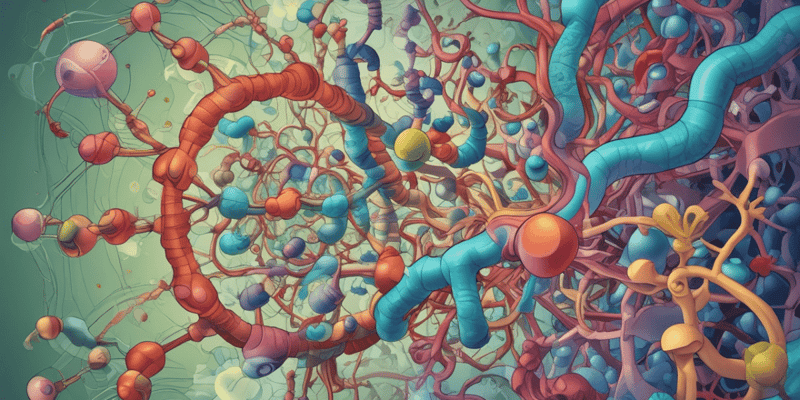23 Questions
Which organic solvents are lipids soluble in?
Ethanol
What is the main chemical bond that combines alcohol and fatty acids in lipids?
Ester linkage
Which type of lipids serve as the structural elements of the cell membrane?
Phospholipids
How are lipids transported in the blood?
Combined with proteins as lipoproteins
What is the main lipid of the mitochondrial membrane?
Cardiolipin
Which phospholipid contains choline and is also known as lecithins?
Phosphatidylcholines
Which phospholipid is called cephalins and contains ethanolamine instead of choline?
Phosphatidylethanolamine
Which phospholipid plays a key role in cell cycle signaling, specifically in relation to apoptosis?
Phosphatidylserine
Which phospholipid is a precursor of secondary messengers?
Phosphatidylinositol
Which type of lipids constitute 10% of brain and muscle phospholipids?
Plasmalogens
Which type of lipids are abundant in brain and nervous tissue and play a role in nerve conduction?
What is the main characteristic of (diphosphatidyl glycerol) Cardiolipin's chemical structure?
The presence of a double glycerophosphate backbone and four fatty acyl chains (R1–R4)
What are the main types of complex lipids?
Phospholipids and glycolipids
What is the main difference between saturated and unsaturated fatty acids?
Saturated fatty acids have higher melting points and are resistant to oxidation, while unsaturated fatty acids have lower melting points and oxidize slowly
Which of the following is an essential fatty acid that cannot be synthesized by mammals?
Linoleic acid
What is the main component of fat stores?
Triacylglycerols
Which type of fatty acids have more than one double bond and are essential for mammals?
Unsaturated fatty acids
What affects the physical and chemical properties of fatty acids, including their melting point and susceptibility to oxidation?
Chain length and degree of unsaturation
Which component forms cardiolipin in mitochondria?
Phosphatidylglycerol
What kind of double bonds do unsaturated fatty acids have that affect their packaging in membranes and complex molecules?
(cis) double bonds
What are the main components of phospholipids?
(Amino) / alcohol, glycerol/sphingosine backbone, and two fatty acids
What is the most correct statement about the physical properties of saturated fatty acids?
Saturated fatty acids have higher melting points compared to unsaturated fatty acids.
Unsaturated fatty acids with what type of double bonds are more common in nature and important for the structure of biological membranes?
Study Notes
- Simple lipids consist of fatty acids and their esters with various alcohols, including neutral oils and waxes. They are mainly saturated.
- Complex lipids contain other groups in addition to fatty acids and alcohols. Phospholipids and glycolipids are main types of complex lipids. Lipoproteins may also be included.
- Precursor and derivative lipids include alcohols, fat-soluble vitamins, and hormones, in addition to fatty acids.
- Fatty acids are long hydrocarbon chains with a methyl group at one end and a carboxyl group at the other. They are amphipathic compounds.
- Most fatty acids in natural oils are straight, even-numbered, and can be saturated or unsaturated.
- Fatty acids differ in length and location of double bonds, and are named by adding the suffix "-oic" to the end of the hydrocarbon chain name.
- Most unsaturated fatty acids in higher organisms have double bonds between carbons 9 and 10. Linoleic and linolenic acids are essential fatty acids and cannot be synthesized by mammals.
- Unsaturated fatty acids have cis double bonds, which affect their packaging in membranes and complex molecules.
- Triacylglycerols, also known as triglycerides, are esters of fatty acids with glycerol and are the main components of fat stores.
- Phospholipids are important components of biological membranes and are derivatives of glycerol and a more complex alcohol, sphingosine, and consist of a glycerol/sphingosine backbone, two fatty acids, and a phosphorylated (amino) / alcohol.
- Phospholipids are divided into 8 classes: phosphatidylglycerol, phosphatidylcholine, phosphatidylethanolamine, phosphatidylserine, phosphatidylinositol, lysophospholipids, plasmalogens, and sphingomyelins.
- Phosphatidylglycerol forms cardiolipin in mitochondria.
- Saturated fatty acids are relatively resistant to oxidation, while unsaturated fatty acids oxidize slowly and spontaneously in air. The melting point of fatty acids increases with the length of the chain and decreases with the number of double bonds.
- Linoleic and linolenic acids are essential fatty acids that cannot be synthesized by mammals and must be obtained from the diet.
- Fatty acids with more than one double bond cannot be synthesized by mammals and are essential.
- Unsaturated fatty acids with cis double bonds are more common in nature and are important for the structure of biological membranes.
- Branched-chain fatty acids are also found in nature and are important components of dairy products.
- Complex lipids, including phospholipids and glycolipids, are important for the structure and function of biological membranes.
- Precursor and derivative lipids play important roles in various biological functions and are precursors for the synthesis of many other lipids.
- Fatty acids are present in cells and tissues as building blocks of complex lipids and as free fatty acids, especially in fasting states.
- The chain length and degree of unsaturation of fatty acids affect their physical and chemical properties, including their melting point and susceptibility to oxidation.
Test your knowledge of the structure, nomenclature, and classification of biological lipids including fatty acids, triacylglycerols, phospholipids, glycolipids, and steroids. Explore the chemical diversity and insolubility in water of these organic compounds essential for living cells.
Make Your Own Quizzes and Flashcards
Convert your notes into interactive study material.
Get started for free



